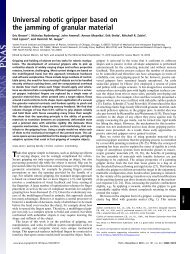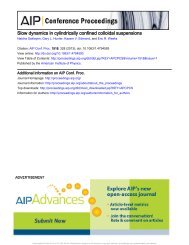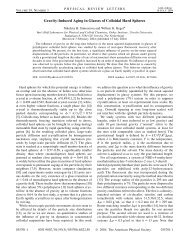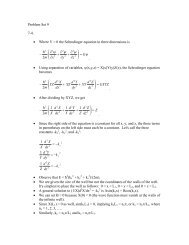Essay contest reveals misconceptions of high school ... - Genetics
Essay contest reveals misconceptions of high school ... - Genetics
Essay contest reveals misconceptions of high school ... - Genetics
Create successful ePaper yourself
Turn your PDF publications into a flip-book with our unique Google optimized e-Paper software.
<strong>Genetics</strong> Education 1165mal recessive, or X-linked inheritance. Students were<strong>of</strong>ten unable to adequately describe sources <strong>of</strong> abnormalchromosome numbers. <strong>Essay</strong>s did not mentionerrors during meiotic cell division and generation <strong>of</strong>gametes as the source <strong>of</strong> monosomies or trisomies. Ourreview <strong>of</strong> state science standards for <strong>high</strong> <strong>school</strong> studentsin biology suggests, not surprisingly, that the majority <strong>of</strong>states provide specific, detailed standards that mandateteaching students, even at the earliest levels <strong>of</strong> their lifescience education in <strong>high</strong> <strong>school</strong>, the basic biology <strong>of</strong>inheritance patterns. Although 15 <strong>of</strong> the 20 biologystandards included basic patterns <strong>of</strong> inheritance knowledge,when we reviewed the essays that were catalogedas having an error or a misconception falling under‘‘patterns <strong>of</strong> inheritance,’’ 80% <strong>of</strong> those essays inaccuratelydescribed a basic tenet <strong>of</strong> Mendelian inheritance,despite their expected coverage <strong>of</strong> this material at theircurrent grade level or in previous biology courses.Nature <strong>of</strong> genes and genetic material: All 20 statestandards examined require coverage <strong>of</strong> the nature <strong>of</strong>DNA as the hereditary material in living things. Nevertheless,students suggested that lower organisms, includingbacteria and fungi, <strong>of</strong>ten do not carry DNA. Wealso noted student confusion regarding the hierarchalorganization <strong>of</strong> genetic material. Notably, students werefrequently unable to accurately define DNA, genes, andchromosomes. Often, these terms were instead usedinterchangeably. In 2007, ,1% <strong>of</strong> essays included anyinformation on additional genetic material in thegenome. Students did not mention gene expressioncontrol elements, repetitive sequences (unless discussingHuntington’s disease), or other nongene elementsin the genome. Finally, students <strong>of</strong>ten described specificprotein-encoding segments, or genes, as discrete elementsthat could easily be removed from one contextand added in a separate context. While this view likelyextends from students learning basic biotechnology andbacterial transformation techniques (for example, addingthe green fluorescent protein from jellyfish tobacterial strains), likening this process to the adding <strong>of</strong>a chemical to a solution is an oversimplification, at best.Genetic basis <strong>of</strong> disease: One <strong>of</strong> the principle errorsobserved in this category was the confusion <strong>of</strong> ‘‘hereditary’’and ‘‘genetic’’ when describing diseases. In a smallsubset <strong>of</strong> cases, 10% <strong>of</strong> the total essays categorized ashaving a misconception in this topic, students completelymisrepresented the genetic nature <strong>of</strong> a specificillness (e.g., calling HIV-1 an inherited disorder). Whilemost illnesses have a genetic component, this does notmake them hereditary. Moreover, while even infectiousdiseases can be considered to have a genetic componentwhether it be <strong>of</strong> the genetics <strong>of</strong> the virus itself or howindividual genetics could result in different manifestations<strong>of</strong> the same illness, students must learn to clarifythese differences. Cancer is a genetic disease. Only rarecancers, however, are hereditary. However, students<strong>of</strong>ten described breast and ovarian cancer as hereditarydue to the mutations in BRCA1 or BRCA2. Whilemutations in these genes <strong>of</strong>ten do result in a cancerpredisposition that appears to be inherited in a dominant-likefashion, the majority <strong>of</strong> breast cancer cases arenot due to mutations in these genes.<strong>Genetics</strong> research: A large number <strong>of</strong> student essaysfocused on the promise <strong>of</strong> genetic engineering inhuman health and reproduction (see also the Reproductivetechnologies section). While superficially this reflectsthat students recognize the positive influence that thestudy <strong>of</strong> genetics can have in their lives, numerous <strong>misconceptions</strong>suggest that students still fail to truly understandthe nature and limitations <strong>of</strong> genetic research.An examination <strong>of</strong> state science standards, briefly describedabove, <strong>reveals</strong> that while state and national process(not necessarily content) standards require coverage<strong>of</strong> the nature <strong>of</strong> scientific research, inquiry, and discovery,this does not necessarily equate to students learningabout how scientists actively perform research. Instead,these process standards reflect the fact that teachers areexpected to provide students with opportunities forinquiry and investigation in the context <strong>of</strong> their ownclassroom laboratory experiments and activities. Inshort, state science standards do not require studentsto learn about the nature <strong>of</strong> scientific research.Reproductive technologies: Misconceptions fallingunder the category <strong>of</strong> ‘‘reproductive technologies’’could have been accurately cataloged under genetictechnologies. However, this class <strong>of</strong> <strong>misconceptions</strong> wasfrequent enough to require special treatment. In thesecases students continued to explore their ideas <strong>of</strong>genetic engineering and cloning to describe the future<strong>of</strong> reproductive control where prospective parents would‘‘improve’’ and ‘‘design’’ their <strong>of</strong>fspring, with the ultimategoal <strong>of</strong> having the ‘‘perfect’’ child. Eugenics, eitherin specific use <strong>of</strong> terminology or in concept, appeared in15% <strong>of</strong> essays collected in 2007. This percentage is notreflective <strong>of</strong> the goals or ongoing work <strong>of</strong> genetics research.Unfortunately, its prevalence in student essays islikely due to both its historical role in research as well asthe ‘‘genohype.’’ Interestingly, the idea behind eugenicsis not overtly described in the standards <strong>of</strong> any statescience standards that we explored. The frequency <strong>of</strong> studentsdescribing using genetics to improve genotypesand design human beings, however, suggests that this iseither the hook that teachers are using or the messagethat students are hearing from the media. More researchwould be required to determine which <strong>of</strong> these optionsis most prevalent.DISCUSSIONRole <strong>of</strong> standards: State science standards are not theonly source <strong>of</strong> direction for what is taught in public<strong>school</strong>s; textbooks, laboratories, statewide assessments,and teacher quality also play significant roles. These



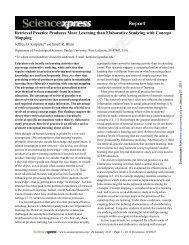
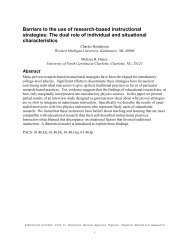
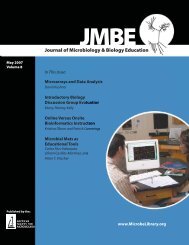
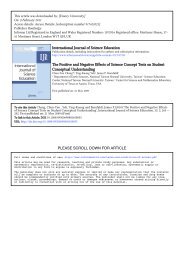
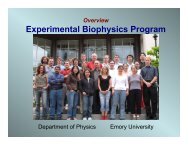
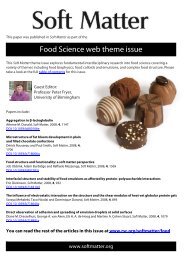

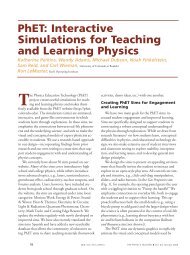
![view the Dish Show [PDF] - Department of Physics - Emory University](https://img.yumpu.com/45032745/1/190x146/view-the-dish-show-pdf-department-of-physics-emory-university.jpg?quality=85)

